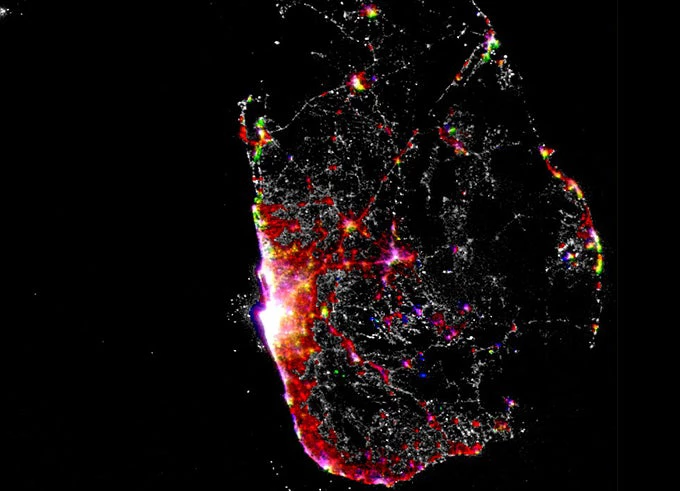Sri Lanka is in many ways a development success story.
Growth of income per person in Sri Lanka has averaged a little more than 7 percent a year over the past five years. That follows average growth of just over 5 percent a year in the preceding nine years. Among the six largest South Asian countries, Sri Lanka has the highest level of economic output per person. With sustained high growth, Sri Lanka has largely eradicated extreme poverty.
All this success has helped propel the country towards middle-income status. Going forward, how successfully Sri Lanka manages its cities will determine how quickly and efficiently the country moves to higher middle-income status and beyond. Every high-income economy has achieved this status through urbanization.
In recent years, Sri Lanka has been one of South Asia’s most dynamically urbanizing countries. This is vividly evident from satellite pictures from nighttime lights. This data shows rapid growth on the periphery of Colombo and along the major transport arteries radiating from the capital towards both Kandy and Galle. The result: Sri Lanka is now home to multi-city agglomerations – continuously lit belts of urbanization containing two or more sizeable municipal or urban councils – that stretch from the metro Colombo region along the corridors to Kandy and Galle-Matara. Rapid urban growth is also observed on the Jaffna peninsula recently.
Expanding urbanization provides Sri Lanka with the potential to further transform its economy. A key trait of urbanization is that the concentration of people and enterprises in cities and towns can improve productivity, stimulate innovation and spur job creation, specifically in manufacturing and services. Indeed, the post-1977 concentration of the garment industry in and around the metro Colombo region played a vital role in helping to drive the export-led growth that has been so important to Sri Lanka’s overall development.
Urbanization is also important for Sri Lanka’s poverty alleviation and shared prosperity. More than half of the people with income in the bottom 40 percent are in fact already located either within or in close proximity to multi-city agglomeration areas. To enjoy the full economic benefit of urbanization countries must successfully address the challenges it poses. Urban growth puts pressure on a city’s infrastructure, its land and housing markets, and the environment.
In many respects, Sri Lanka has done better than its South Asia counterparts in handling these congestion forces, according to a new World Bank report – Leveraging Urbanization in South Asia: Managing Spatial Transformation for Prosperity and Livability. Sri Lanka’s urbanization has been far less “messy” – as evidenced by the relative absence of slums and extreme urban poverty – than in the rest of the region, the report found. And its cities have less air pollution than other cities in the region. Still, Sri Lanka is facing obstacles in meeting the challenges posed by urbanization. The World Bank report found that the country suffers from considerable “hidden urbanization,” where official national statistics understate the share of population living in areas with urban characteristics.
There is evidence that as much as one-third of Sri Lanka’s population may be living in these unrecognized urban areas. Acknowledging the true extent of urban areas would help to facilitate better planning and metropolitan management as well as the delivery of public services. Actions in several areas can help fulfil the potential of Sri Lanka’s cities and further bolster the nation’s economic momentum. As in the rest of South Asia, improvements in the ways in which cities are governed and financed present the opportunity to improve basic service delivery and help address congestion constraints.
Steps to improve the ways in which the nation’s cities are connected and planned, to reform land and housing policies to address the country’s housing shortage, and to ensure that adequate flood protection measures are in place can also help ensure Sri Lanka reaps its full urban dividend. In taking action, it is important to recognize that one size may not fit all and every country has to find its own way in managing urbanization.
Targeted solutions that build on local characteristics and conditions may offer the best opportunity to achieve the desired results. Whether it’s continually re-inventing downtown areas of cities like Colombo and Kandy, better managing growth on metropolitan peripheries, or increasing the connectivity of Batticaloa and Jaffna and other urban settlements in the north and east of the country, it’s all about making cities places that people want to live and work, and where firms can be productive and innovate.
Today, Sri Lanka is ahead of most South Asian nations in this regard. Steps to further improve the management of its cities can keep Sri Lanka on an upward economic path and help it join the ranks of richer nations in terms of both prosperity and livability.




Join the Conversation